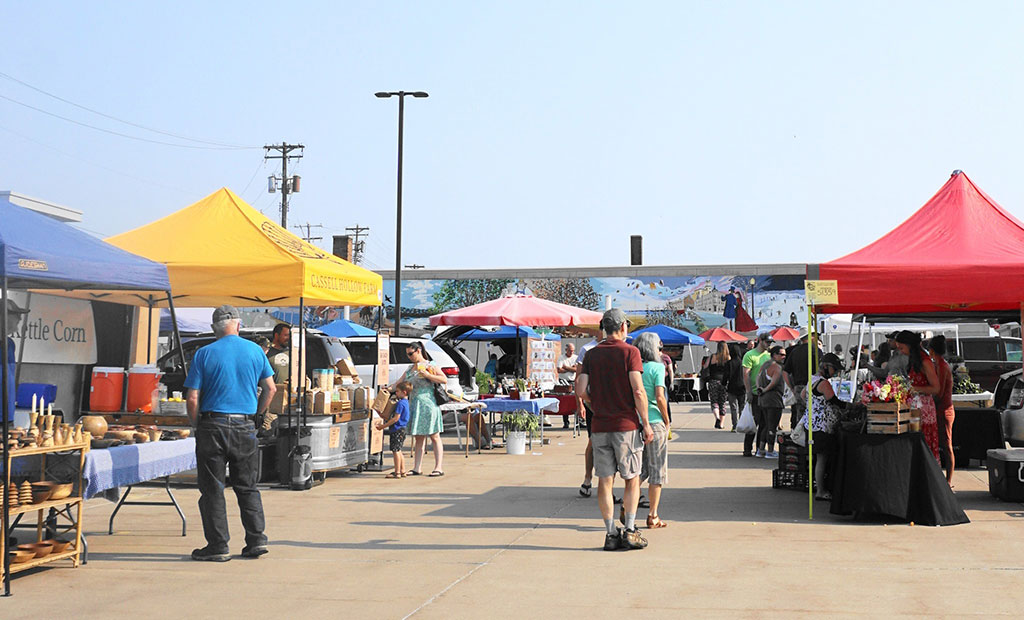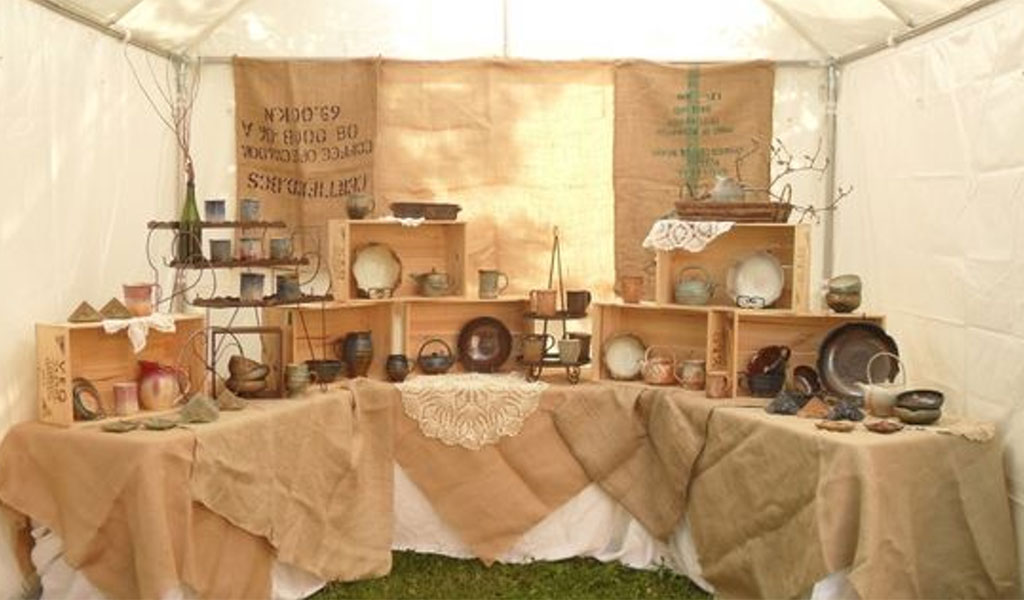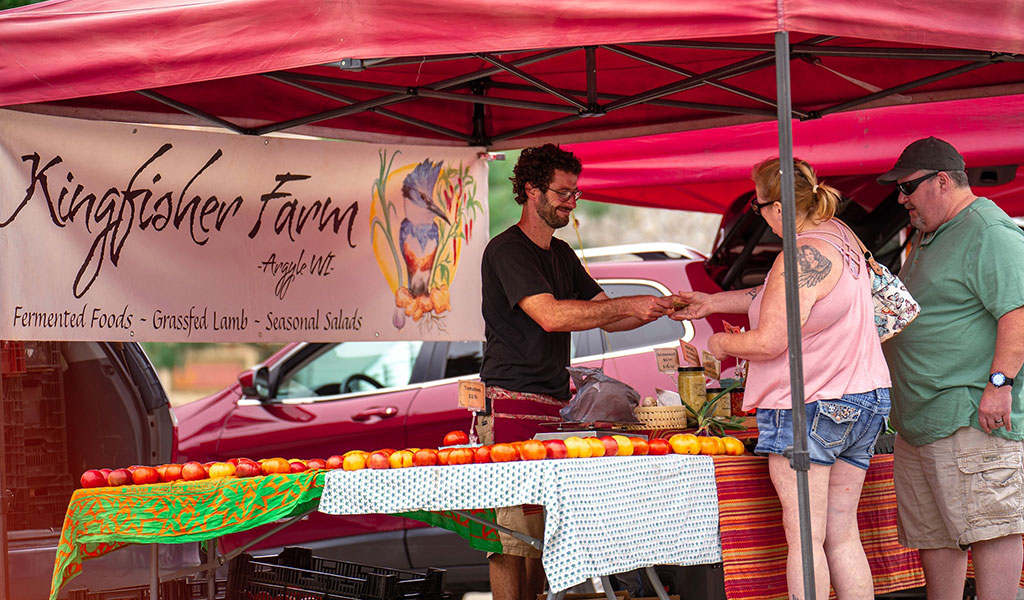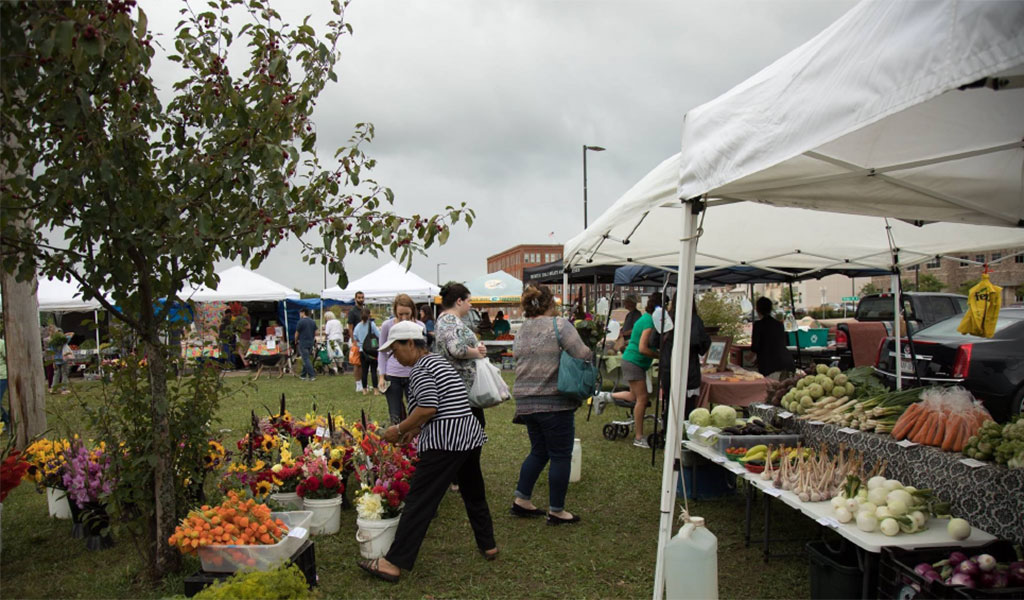
Community members enjoy a variety of vendors at the Viroqua farmers market.
To plan for a successful, fun farmers market, it can help to do your homework on what works and what doesn’t in other Wisconsin communities and to learn from the expertise of market gurus.
Farmers markets are a popular way to bring people together to buy fresh produce and explore everything downtown has to offer. They also support local entrepreneurship that contributes to a downtown’s future business success.
Farmers markets offer local producers and vendors an opportunity to showcase their products, gain new customers and make a profit—all while also giving attendees a chance to stock up on essentials and discover new businesses.
Here are some tips for planning and boosting your market and helping vendors maximize sales.
PLANNING EFFECTIVE VENDOR BOOTHS
Market vendors should begin by planning their booth layout and functionality and then employ fun elements to make their booths visually appealing. Visual merchandising calls for making booths aesthetically pleasing, cohesive and a part of the central brand.
Your booth is your brand, and it should clearly represent your product and image, says Amy Meadows, a booth merchandising expert from Windows Matter. This will allow you to stand out among other vendors and create the optimal customer experience, says Meadows, who has conducted several trainings for Wisconsin Main Street.

This professional-looking display uses inexpensive items to showcase the vendor’s ceramics in an attractive manner.
Focus on layout, functionality
The first step is to plan the layout of your booth.
Use visual tools to help envision the booth. First, draw out an elevation view—the view customers get when looking at the front of your booth. Then, sketch out the plan view—a view from above showing the booth’s footprint.
Creating these visuals will help to map out where to place your products and merchandise, where you will have your point of sale and where you will stand. This way you’ll be able to move items and displays around while the plan is still on paper, rather than having to make changes once the booth has been physically created.
When developing your plan, Meadows suggests thinking about the design, problem solving and logistics. What kind of props, backdrops and other elements will you use, and how will they be displayed?
Create balance by using different elevations. In addition to having products on the table, you can hang some items and display others on the ground.
You’ll also want to keep in mind your signage when planning your display. Plan to either have your logo up high where it is easily legible or on the table where items are displayed. If the logo or business name is too low or on the tablecloth, it will easily get covered up with customers standing in front of it or setting items down.
Catching the attention of marketgoers is key. Meadows says it is important to think about customers’ peripheral view and create displays that they will catch out of the corner of their eye. Some strategies include adding a sign that sticks out of your booth perpendicular to foot traffic, adding a display at the booth’s edge to draw people in, and having tiered merchandising, with the bottom tier just at the booth’s edge.
Think about the traffic around your booth. Will your customers have aisles to go down and around to view all your products, or will your items be displayed centrally? Your booth should have a flow, and you should experiment to figure out which flow and layout works best for your brand and customers.
Finally, consider how and where you will ring up sales. Your point of sale, Meadows says, needs to be flexible, multipurpose and space efficient. Consider what forms of payment you will take, where customers can set their purchases and how you will create receipts.
Incorporate fun elements
The next step is to add fun and creative elements to your booth to make it visually appealing. This doesn’t have to be expensive. Meadows wants vendors to think cheap and cheerful. She encourages vendors to search for props and backdrops at home improvement stores, craft stores and dollar stores, as well as on Facebook Marketplace and Etsy.
Logistically, think about adding fun elements that are light, can be flattened, can nest, collapse or are stackable. If you typically set up your display by yourself, this will help you to be efficient and make setup a breeze.
Some items Meadows suggests are boxes, ladders, crates, music stands, clipboards to hang jewelry, and embroidery hoops. Think of items that are fun, cheap and easily customizable—and if you are going to do it, do it big, she says: If you think you want three clipboards, do nine or 12 instead. Ultimately, your booth should delight your customers and drive sales.

Good signage with your logo up high where it is easily seen helps attract customers.
TIPS FOR FARMERS MARKET VENDORS ON HOW TO STAND OUT
Although branding and merchandising play a huge role in making vendor booths draw attention, here are some other tips on how vendors can operate their booths successfully and profitably.
Uniqueness: Consider what sets your booth apart from other vendors and producers and share that with your customers. What do you love about your products? What do you grow best and love the most? How do you use your products? Do you have products that no one else has? What special knowledge can your customers get from you and you only?
Eye on the sun: Pay attention to where the sun is going to be and arrange your booth accordingly. If you do not have enough shade for everything, put the most sensitive products in the shadiest spots, and put out small quantities for any products that will wilt. Keep the rest in coolers with ice.
Communicating prices: Put out signs with prices that are clearly marked or have a price tag for every product, and make sure the tag stays with the product. Don’t put items bearing different prices in the same basket. Customers do not want to ask you for the price of every item, and not having prices listed can sometimes deter them from buying.
Educating customers: If you offer unusual products, be prepared to explain what they are and how to use them. Recipe cards are a great idea—or a website with recipes and links to more information. Be ready to describe your farming practices. Have an answer ready if a customer asks why your prices are higher than the grocery store. If your market has cooking demonstrations, donating your products can be a great way to highlight them. Be prepared to explain the qualities of different varieties. If a customer asks which is the best, encourage them to try them all so they can decide which they prefer.
Differentiate your products: Your products should be unique in some way. Maybe they are the freshest tomatoes or the largest watermelons. Whatever the case, make sure that differentiation is clear to people walking by your booth.
Do a dry run: Before you head out to the market, set up your booth at home to make sure everything fits and see if there are any areas that you could improve.
Keep detailed checklists: Make a checklist that includes everything you need to bring, from the actual products to the items you need to set up your booth and display your items. By creating and using a checklist you can easily prepare for every event and make sure you have everything you need.
Market yourself: When customers approach your booth, greet them in a friendly way and make sure they know you are available to answer questions. Do not be pushy but do engage them in conversation when the opportunity presents itself. As the vendor, you are a big part of how shoppers perceive your booth. Dress comfortably but look clean and professional so people feel good buying food or other items from you.
Keep the line moving: If people walking by see a huge line, they might pass by without stopping. Try to move through the line quickly without pushing customers away.
Answer questions while selling: Multitasking is a must in this setting. Practice accepting payments while answering questions from other customers so you can keep the line moving while providing excellent customer service.
SURVEY REVEALS STATEWIDE MARKET TRENDS
Survey data assembled by WEDC from Connect Communities and Wisconsin Main Street communities that host farmers markets every year provide helpful insights on staging a successful market. They also help communities set achievable goals when planning for markets.
To account for differences among communities based on size, some survey responses are qualified for smaller communities (those under 5,000 in population) versus larger communities.
Farmers markets differ
While many communities host farmers markets every summer, markets vary widely in terms of the day and time they are held and the types of entertainment offered. Based on survey results, Wednesdays and Saturdays are equally popular for communities to host their weekly markets, followed by Thursdays. Sundays are the least popular.
While 78% of communities host one market per week, 22% host two each week. Mornings are the most popular time of day, with evenings coming in second, and afternoons being least popular at 22%. Most markets are held 20-some times per year, although some extend the season by offering winter markets.
Of the communities surveyed, 60% host their farmers markets on the main street in the downtown, while 20% host markets in a park and the remaining 20% in a parking lot. According to the survey, 44% of the markets include entertainment such as music, car shows and radio station participation, while the other 56% do not include entertainment.
The average community budget for a farmers market was $24,227 (ranging from $250 to $200,000), with small communities averaging $2,460 and large communities averaging $51,438. The average net revenue per community was $2,975 (ranging from $300 to $6,500), with small communities averaging $2,375 and large communities averaging $2,783.
When it comes to making a market profitable, tips include offering a dynamic line-up with a mix of vendors; offering tokens or marketing incentives; encouraging attendees to visit downtown businesses; and offering businesses free vendor spots and/or a location in front of their business if it happens to be within the market area.

This farmers market includes local producers and vendors selling a variety of items from produce to fresh cut flowers.
Vendor and business participation
The vendor and business mix is arguably the most important part of planning a successful farmers market.
Some communities host produce and value-added-only markets, while others include local businesses, resellers, crafters and prepared-food vendors as well. It is important to choose the best vendor mix to serve your community’s needs.
Based on survey results, the average number of vendors at each market is 39 vendors, with small communities averaging 24 vendors and large communities averaging 58 vendors.
Communities were also asked what kind of vendors they allow at their market, including non-local vendors, non-food vendors, prepared-food vendors, resellers and local business booths. Most communities (89%) welcome non-food vendors, and 78% host prepared food vendors. A little more than half of the communities welcome non-local vendors, 33% allow local business vendors and a handful welcome resellers.
All of the communities surveyed charge their vendors and businesses to participate, with an average fee of $13 per market. Two-thirds of communities charge $10.
While most attendees visit the market for a specific purpose, many will continue to explore local businesses while downtown. That makes it important for local businesses to be open during the market and capitalize on the potential extra customers. Based on the survey, 75% of businesses are open during the markets, with small communities averaging 66% and large communities averaging 86%. Of the communities that collected data on sales at downtown businesses during farmers markets, 67% reported a sales increase and 33 percent reported no change.
Farmers market visitors
The data show that average weekly attendance at markets is 1,593, with small communities averaging 618 and large communities averaging 2,813.
The range of attendees per market per community is 20 to 10,000, with more than half of communities falling in the 301 to 700 range. On average, 15% of market visitors make additional purchases downtown.
